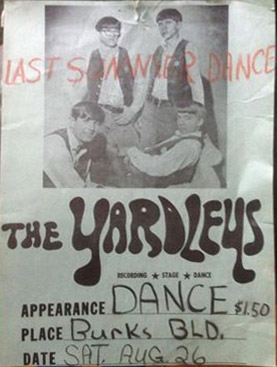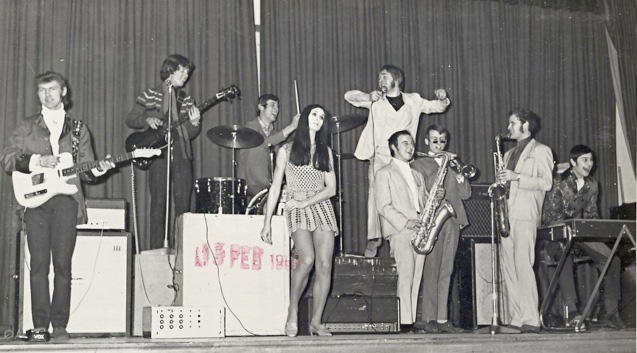
Richard Bennett – lead vocals
Tony Tacon – lead guitar
Ian Orton – keyboards
John Barter – tenor sax
George Russell – tenor sax
Ron Lewingdon – trumpet
Steve Priest – bass/vocals
Alan Bennett – drums
West London R&B/soul connoisseurs The Army have the distinction of being the group that spawned future Sweet bass player/singer Steve Priest.

The Army’s roots can be traced as far back as 1962 when cousins Richard Bennett (lead vocals) and Alan Bennett (drums) decided to form their first band, The Satellites in Hayes, west London.
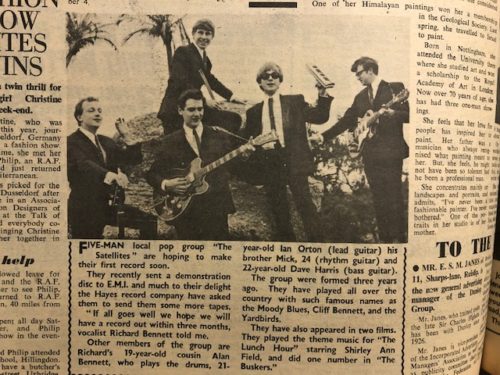
Joined by Dave Harris (bass) and siblings Ian Orton (lead guitar) and Mick Orton (rhythm guitar), The Satellites had an early brush with fame when they appeared on the set of the James Bond movie Goldfinger in 1964.
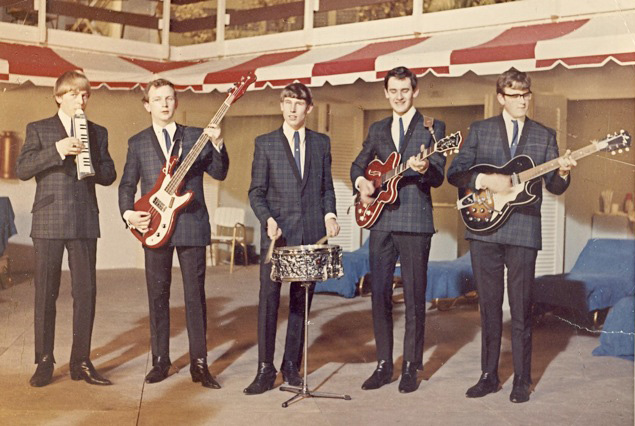
Around mid-July 1966, however, The Satellites underwent a significant reshuffle, starting with the addition of lead guitarist Tony Tacon, whose main claim to fame is that he had been a member of local rivals, The Javelins with future Deep Purple singer Ian Gillan during 1962-1964.
Gillan left to join Wainwright’s Gentlemen in November 1964 (Ed: future Sweet drummer Mick Tucker joined during late 1965) and Tacon joined Ealing band, Four Jacks and a Joker before hooking up with West Drayton outfit, The Ways & Means for a few months.
“I got a knock on my door from Clem [Clemson] who had been a part-time manager of The Javelins,” remembers Tacon. “He said that The Satellites were looking for a new lead guitarist if I was interested. I went down to Uxbridge for an audition and joined.”
With Tacon’s arrival, Ian Orton moved on to keyboards. At the same time Mick Orton dropped out. The following month, the band decided to remodel itself on Cliff Bennett & The Rebel Rousers by bringing in some horn players.
For the proposed horn section, Tacon recommended his friend, sax player John Barter, who had played alongside the guitarist in Four Jacks and a Joker. Barter in turn introduced his friend, fellow sax player George Russell, a former member of Twickenham-based R&B outfit, Jeff Curtis & The Flames.
Not long after Dave Harris departed and future Sweet bass player Steve Priest took his place.
“Steve Priest joined as our new bass player,” continues Tacon. “I remember us going around to see him at his parents’ house in Hayes. I was familiar with him from his Countdowns days but someone else in the band had made contact with him.”
According to Steve Priest’s book Are you Ready, Steve? it was Richard and Alan Bennett who approached him to join. Priest would later recruit future Army members, guitarist Richard Herring and organist Dennis White from his former group The Countdowns.
Tacon remembers one of his first gigs with the group (still billed as The Satellites) was in south Wales.
“I remember playing Afan Lido (Port Talbot) probably in their gym. It was early on after I joined The Satellites. Straight down the M4 and back the same day. Beautiful sunny day (so not winter) and I remember us relaxing on the nearby beach until the gig started. I reckon it was a regular dance venue as girls told us that they came down each week.” (Ed. The Port Talbot Guardian lists this as 23 July 1966 with Something Else in support)
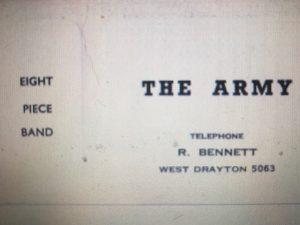
Renamed The Army, in view of the increased number of personnel in the band, Richard Bennett, who worked as a sign writer, painted the new moniker, surrounded by instruments, on the sextet’s new purchase, an old 30cwt van.
“The van was so big that we used to have to take it in turns to have it for a week and park it outside our homes,” says Tacon.
From the outset, The Army’s repertoire was entirely comprised of cover material, mixing popular US R&B/soul numbers like Lee Dorsey’s “Ride Your Pony”, The Four Tops’ “Reach Out, I’ll Be There”, Larry Williams’s “Slow Down” and Wilson Pickett and Steve Cropper’s “In the Midnight Hour” (which Steve Priest sang) with British classics, such as Zoot Money’s “Big Time Operator”.
At first, the revamped and renamed outfit found gigs at its local haunt – the Grange Club in Hayes. Interestingly, they were also invited to perform at several garden parties for the Tory party.
“I was impressed by the sort of gigs that we did,” recalls Tacon. “The band was well in with the Young Conservative Association, how I don’t know, and played at many of the functions in London and the Home Counties.”
Tacon remembers the band playing at the Bell House Hotel in Gerrards Cross, a venue in Harpenden with a Liverpool band that might have been The Undertakers and also at an RAF base at Dawes Hill near High Wycombe.
During this time, the guitarist also remembers the band landing a gig at the Queen’s Building in the centre of London (Heathrow) Airport and sharing the dressing room with Kenny Ball & His Jazzmen.
In late October, The Army played at a Halloween Party at a hotel opposite the airport, which was put on by a film producer.
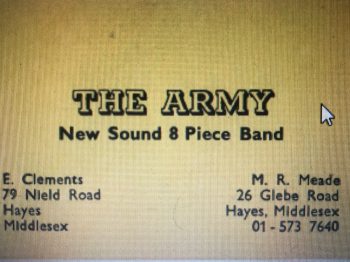
More significant, the sextet started performing on London’s busy club scene, including shows at the Starlite Ballroom in Greenford and the 100 Club (Ed: this might have been Tiles) on Oxford Street.
“One night we played a dance hall in the Amersham area… then went straight off to the centre of London where we played [at Tiles] in the early hours of the morning. The Birds may have been on before us,” recalls Tacon.
“I remember that Steve [Priest] had some friends with him at that gig and one of them was robbed on the dance floor. My fiancée (now my wife) saw it happen and says that the gang turned Steve’s friend upside down to empty his pockets.”
Priest’s book doesn’t mention this incident but does note that the venue the group played after the Amersham area gig was Tiles on Oxford Street. Interestingly, The Army did play the Legion Hall in Amersham on 25 February 1967 and later that evening appeared at Tiles on Oxford Street (see selected gig list below).
As the band’s popularity grew, The Army ventured further afield, including shows in Cardiff (3 February 1967), Dunstable, Birmingham and Nottingham among others.
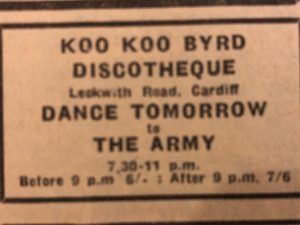
Tacon remembers the sextet playing a converted warehouse in Birmingham and John Mayall’s Bluesbreakers were in the dressing room when they arrived [Ed: this was Midnight City on 19 November 1966, although the group is not advertised in Birmingham Evening Mail].
“I remember John Mayall sitting there smoking a spliff. The window at the end of the room looked out on to a large intersection and bang opposite was Digbeth police station,” continues the guitarist.
“We left our gear and all went off to the Bullring for something to eat, missing the Bluesbreakers’ set. I have often wondered if Eric Clapton was in the room that night, but after comparing notes with Steve Priest; he assures me that it was the first gig [sic] for Peter Green, who he saw frantically practising in readiness having just taken over from Clapton.”
Tacon adds that The Army played at the Dungeon Club in Nottingham the next evening, a venue that he recalls playing at least twice during his time with the band. [Ed: this would have been 20 November 1966. Again, the local paper, The Nottingham Evening Post does not list them, but rather The Amboy Dukes]
Another notable gig took place on Christmas Eve when The Army opened for their idols, Cliff Bennett & The Rebel Rousers at Burton’s in Uxbridge.
“I must have left in my own van earlier than the others after the gig because the next morning (Christmas Day), two of the band, probably Richard and Alan turned up with my share of the money,” recalls the guitarist.
“They were good lads in that band. I went all over the place with them and do not remember any upsets at all.”
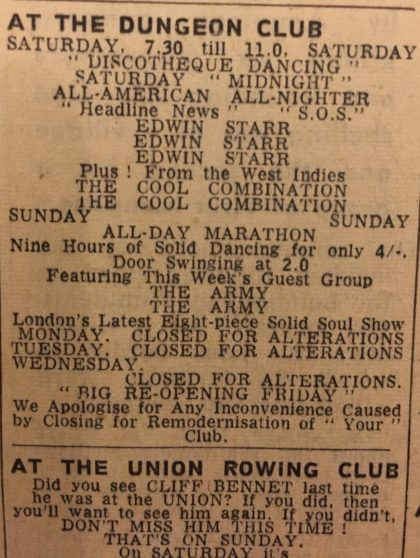
During January 1967, Tacon introduced trumpet player Ron Lewingdon and The Army became a seven-piece act.
“He approached me about joining when he saw me driving the band’s van one day in the company car park,” explains the guitarist. “I was working in the tool room at the same company at the time. I put it to the others and he was in.”
With Lewingdon on-board, The Army played at the Adelphi Ballroom in Slough (18 March 1967) and Tacon’s old mate from The Javelins, Ian Gillan turned up and ended up taking photos of the group performing from the side of the stage.
“Ian came with me in my car to see the band for the first time,” continues the guitarist. “I had been going to see him in Episode Six, so he repaid the compliment. He was best man at my wedding later that year.”
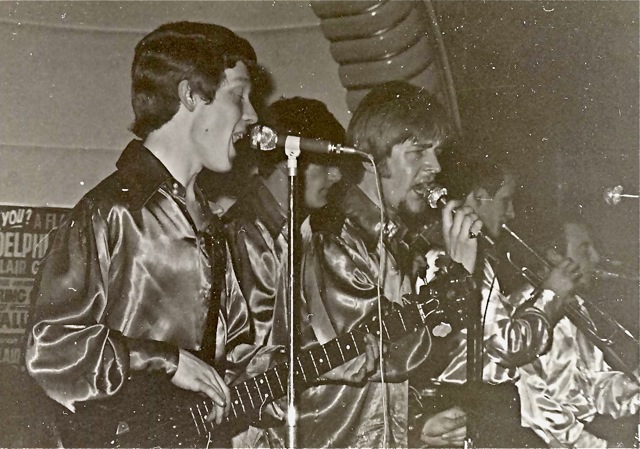
On this particular night Richard Bennett’s PA played up and the singer remembers borrowing one from Ian Gillan. Tacon adds that the future Deep Purple singer also took the photo.
However, not long after, Tony Tacon handed his notice. The guitarist was indeed engaged and got married soon after; it was time to hang up his rock ‘n’ roll boots. In fact, Tacon didn’t play in a band again until The Javelins reformed in the early 1990s to record a CD. He currently plays with Lincoln band, Something Else.
The guitarist remembers that his last gig with The Army took place at the California Ballroom in Dunstable on 25 March 1967.
“There were three bands on that night,” he says looking back. “The Troggs were top of the bill and we shared the dressing room with them. I remember being impressed that they arrived in an Austin Princess and brought a portable black and white TV with them that was set up in the dressing room.”
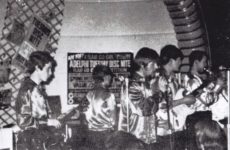
With former Countdowns guitarist Richard Herring taking over on lead guitar and ex-Countdown Dennis White subsequently replacing Ian Orton on electric organ, The Army cut two tracks in late 1967 that were shelved until 2014 when this author helped secure the release of the band’s cover of the Joe Tex hit, “Sugar” on Acid Jazz’s Rare Mod Volume 5. The band’s cover of the Sam & Dave hit “You Don’t Know Like I Know” remains unreleased.
On 14 October, The Army returned to the California Ballroom to support Georgie Fame. Two months later, they played two shows at Burton’s in Uxbridge, the latter on New Year’s Eve, opening for Cliff Bennett & The Rebel Rousers.
Sometime around this period, the group turned up at Chelsea Barracks to audition for Opportunity Knocks.
The Army continued to gig during early 1968, playing venues like Walton Hop. However, behind the scenes, Steve Priest began rehearsing with The Sweetshop (aka Sweet) on the side.
“I was a fan of smaller bands like Cream,” says Priest on his decision to explore new avenues. “The Army and Wainwright’s Gentlemen played at Ealing Town Hall on the same night. Mick [Tucker] was fired that night and Brian [Connolly] resigned.”
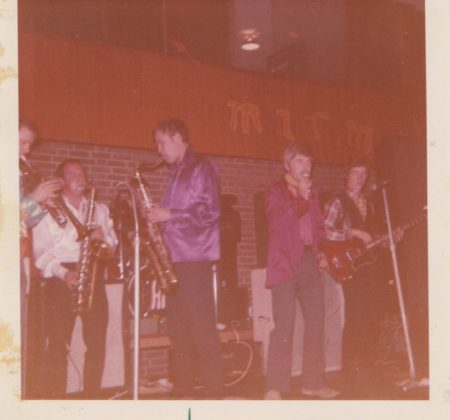
Not long after playing a show at the Grange Club in Hayes in mid-February (see date stamped top picture), Priest announced his decision to leave The Army, playing his debut gig with The Sweetshop (subsequently shortened to The Sweet) on 9 March at Hemel Hempstead Pavilion.
Taking on a new bass player called Chris from Ealing, The Army continued to gig, including a clutch of shows at the New Pink Flamingo in Soho, Cooks Ferry Inn in Edmonton, north London and also opened for The Easybeats at St Albans City Hall.
By this point, Richard Herring had also departed and former Casuals’ lead guitarist Geoff Foster had joined. Not long after Dennis White left to join Merlin Q.
The group continued to pick up gigs, playing venues like Samanthas in New Burlington Street in London
Then, around September 1968, Pete Burt took over the drum stool from Alan Bennett. Burt had worked with George Russell in Jeff Curtis & The Flames during 1965 and had stuck with the group when it became The Kool. Bennett’s departure prompted Ron Lewingdon to also drop out.
Alan Bennett and Ron Lewingdon stuck together. Reunited with former member, the late Ian Orton on rhythm guitar and lead vocals and siblings Ray Spiteri (lead guitar) and Bob Spiteri (bass), they formed The Occasions and landed a prestigious gig at the Hilton Hotel on Park Lane the early 1970s.
The remaining members continued into early 1969 before splintering. Pete Burt briefly gigged with Bob Brittain and then formed Hogsnort Rupert, the house band at the Clay Pigeon in Eastcote.
Geoff Foster joined soul band, The Orange Rainbow (John Barter and George Russell both guested). Russell (and later Richard Bennett) emigrated to Australia but Russell subsequently returned to the UK.
Notable gigs:

3 September 1966 – New Central Ballroom, Aldershot, Hampshire with The Simon Dupree Sound (billed as The Satellites)
9 September 1966 – Starlite Ballroom, Greenford, west London with The Jimmy Brown Sound (billed as The Satellites)
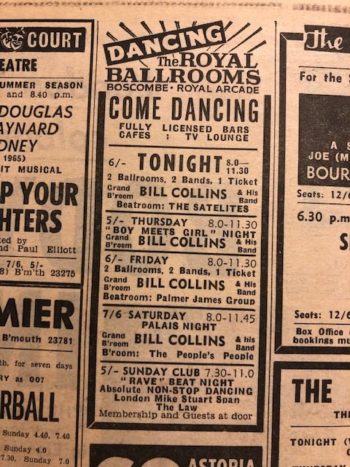
27 October 1966 – Royal Ballrooms, Boscombe, Dorset (billed as The Satellites)
19 November 1966 – Midnight City, Digbeth, Birmingham with John Mayall’s Bluesbreakers (Tony Tacon’s memories: they must have replaced either Wynder K Frog or The Times who were also advertised)
20 November 1966 – The Dungeon, Nottingham (Tony Tacon’s memories: they must have replaced The Amboy Dukes who were advertised in Nottingham Evening Post)
24 November 1966 – Stereo Club, Wycombe, Bucks (billed as The Satellites)
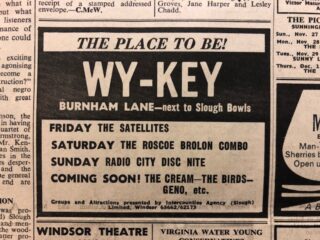
25 November 1966 – Wy-Key Club, Burnham Lane, Slough, Berkshire (billed as The Satellites)
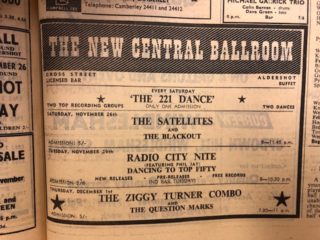
26 November 1966 – New Central Ballroom, Aldershot, Hampshire with The Blackout (billed as The Satellites)
24 December 1966 – Burton’s, Uxbridge, northwest London with Cliff Bennett & The Rebel Rousers
11 February 1967 – Kookoo-Byrd Discotheque, Cardiff, Wales
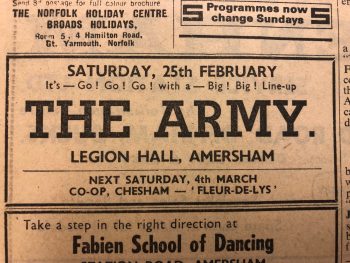
25 February 1967 – Legion Hall, Amersham, Bucks
25 February 1967 – Tiles, Oxford Street, central London with The Gamblers and The Essex Five
5 March 1967 – Dungeon, Nottingham
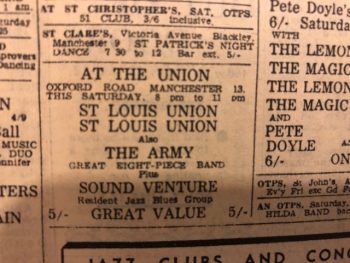
18 March 1967 – At the Union, Manchester with St Louis Union and Sound Venture (Tony Tacon doesn’t recall this gig at all, even though it was advertised)
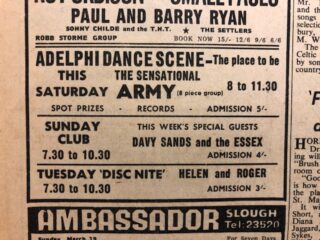
18 March 1967 – Adelphi Ballroom, Slough, Berkshire
25 March 1967 – California Ballroom, Dunstable, Bedfordshire with The Troggs
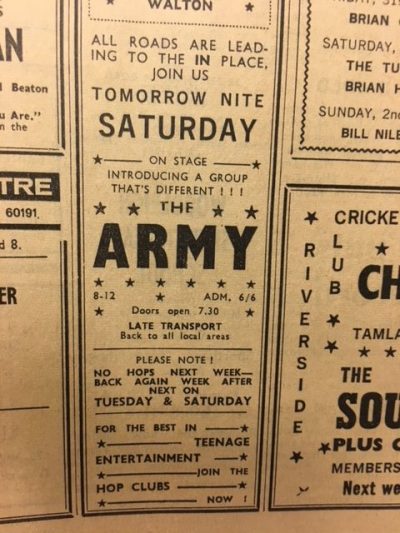
1 April 1967 – Walton Hop, Walton-on-Thames, Surrey
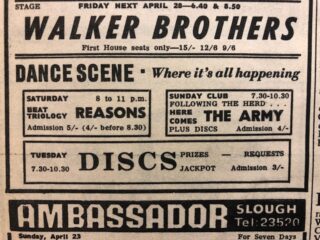
23 April – Adelphi Ballroom, Slough, Berkshire
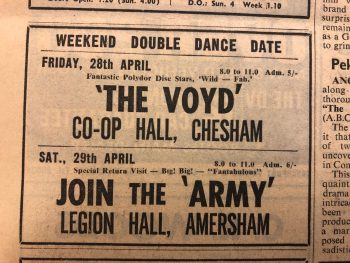
29 April 1967 – Legion Hall, Amersham, Bucks
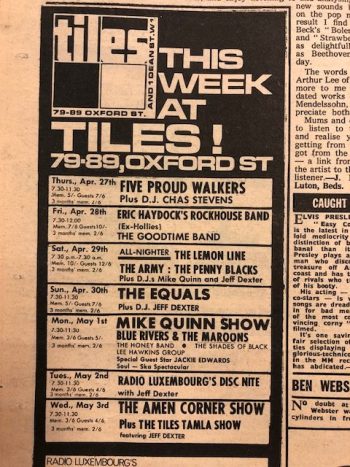
29 April 1967 – Tiles, Oxford Street, central London with Lemon Line and The Penny Blacks

11 May 1967 – Upper Cut, Forest Gate, east London with The Jokers and The Afex
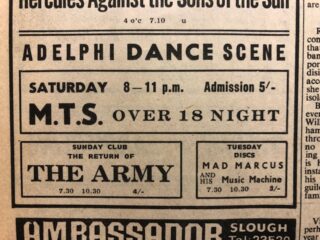
28 May 1967 – Adelphi Ballroom, Slough, Berkshire
2 July 1967 – Starlite Ballroom, Greenford, west London with The Toys
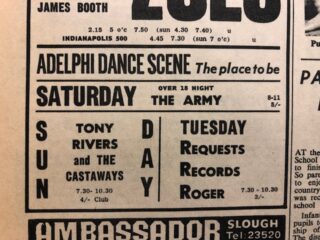
15 July 1967 – Adelphi Ballroom, Slough, Berkshire
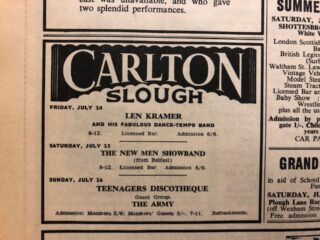
16 July 1967 – Carlton Ballroom, Slough, Berkshire

29 July 1967 – Tiles, Oxford Street, central London with The Gass and The Fraternity
19 August 1967 – Tiles, Oxford Street, central London with Coloured Raisins and Tiles Big Band
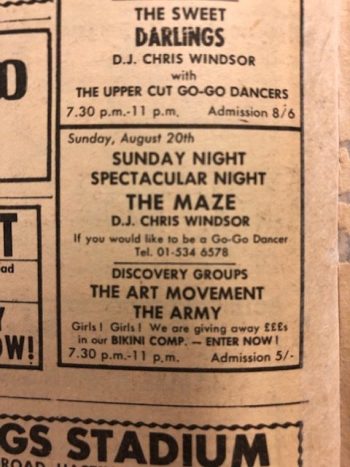
20 August 1967 – Upper Cut, Forest Gate, east London with The Maze and The Art Movement
23 August 1967 – Drayton Hall, West Drayton, west London
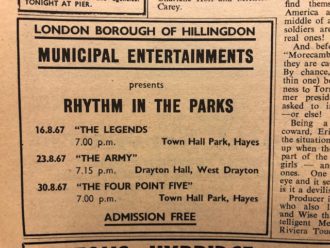
23 August 1967 – Town Hall Park, Hayes, west London
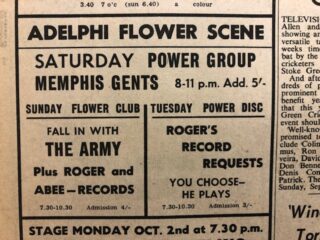
3 September 1967 – Adelphi Ballroom, Slough, Berkshire
14 October 1967 – California Ballroom, Dunstable, Bedfordshire with Georgie Fame & Four Point Five
24 November 1967 – Private engagement (according to Melody Maker)
25 November 1967 – Clay Pigeon, Eastcote, northwest London
26 November 1967 – Starlight Ballroom, Crawley, West Sussex with Ronnie Jones & The Q-Set
27 November 1967 – Private engagement (according to Melody Maker)
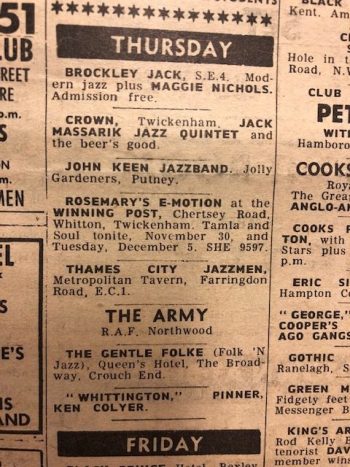
30 November 1967 – RAF Northwood, Hertfordshire
1 December 1967 – Private engagement (according to Melody Maker)
2 December 1967 – Burton’s, Uxbridge, northwest London
3 December 1967 – Starlight Ballroom, Crawley, West Sussex with The Temptations (this was The Fantastics not the Motown group)
31 December 1967 – Burton’s, Uxbridge, northwest London with Cliff Bennett & The Rebel Rousers (this requires confirmation)
5 January 1968 – The Hub, Marlow, Bucks
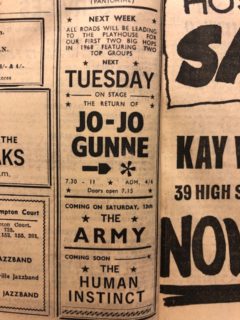
13 January 1968 – Walton Hop, Walton-on-Thames, Surrey
20 January 1968 – Starlight Ballroom, Crawley, West Sussex with Radio Disc Show with Stuart Henry
According to Frank Torpey’s diary, Steve Priest was rehearsing with The Sweetshop (aka The Sweet) by 5 February and would have left a few weeks later.
Frank Torpey’s final gig with Wainwright’s Gentlemen was 20 January and Mick Tucker was fired shortly afterwards so the Ealing Town Hall gig where Wainwright’s Gentlemen and The Army both appeared was probably in the last week of January 1968.

10 February 1968 – The Ritz, Bournemouth, Dorset
Mid (13?) February 1968 – The Grange, Hayes, west London (picture has Steve Priest in it, so one of his final gigs with the band)
3 March 1968 – Slough Adelphi, Slough, Berkshire (Priest may have played this but very unlikely)
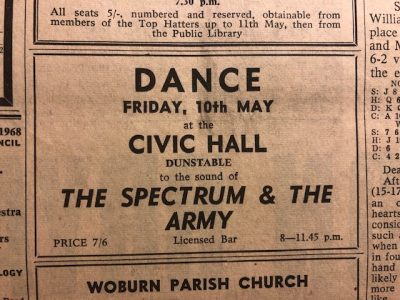
10 May 1968 – Dunstable Civic Hall, Dunstable, Beds with Spectrum
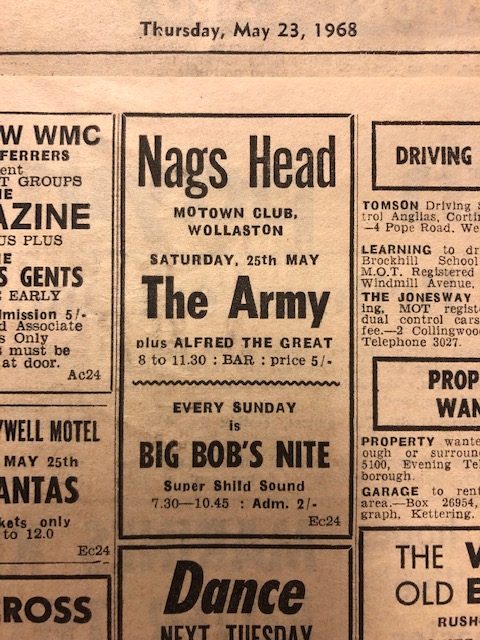
25 May 1968 – Nags Head, Motown Club, Wollaston, Northamptonshire with Alfred The Great
26 May 1968 – New Pink Flamingo, Wardour Street, central London

30 May 1968 – St Andrew’s Hall, Uxbridge, northwest London
2 June 1968 – New Pink Flamingo, Wardour Street, central London with The All-Nite Workers (billed as Army Soul Show)
14 June 1968 – Ritz, Bournemouth, Dorset
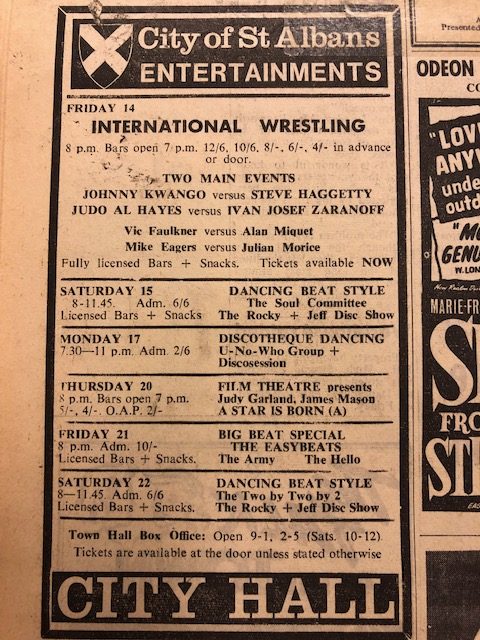
21 June 1968 – St Albans City Hall, St Albans, Hertfordshire with The Easybeats and The Hello
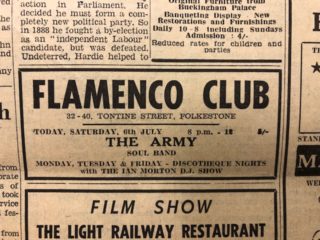
6 July 1968 – Flamenco Club, Folkestone, Kent
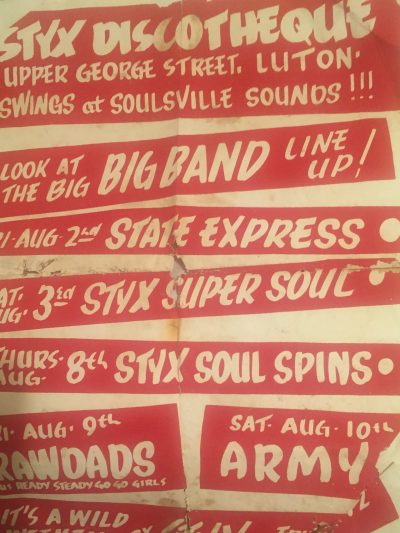
10 August 1968 – Styx Discotheque, Luton, Bedfordshire
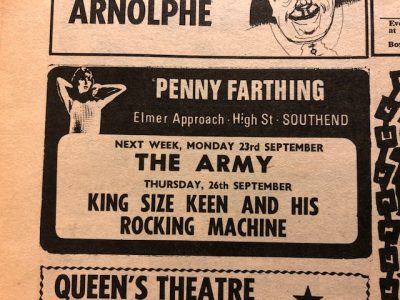
23 September 1968 – Penny Farthing Club, Southend-on-Sea, Essex with Kingsize Keen and His Rockin’ Machine
I would like to thank Tony Tacon, Richard Bennett, Alan Bennett, Ron Lewingdon, Steve Priest, John Kerrison, Geoff Foster, George Russell, John Barter and Keith Kendall for providing some information about this band. Thanks to Richard Bennett, George Russell and Tony Tacon for providing images.
Gigs were sourced from various national newspapers and Melody Maker (some sources are noted in the comments below).
Copyright © Nick Warburton. All Rights Reserved. No part of this article may be reproduced or transmitted in any from or by any means, without prior permission from the author.
I have tried to ensure the accuracy of this article but I appreciate that there are likely to be errors and omissions. I would appreciate any feedback from anyone who can provide any additions or corrections. Email: Warchive@aol.com


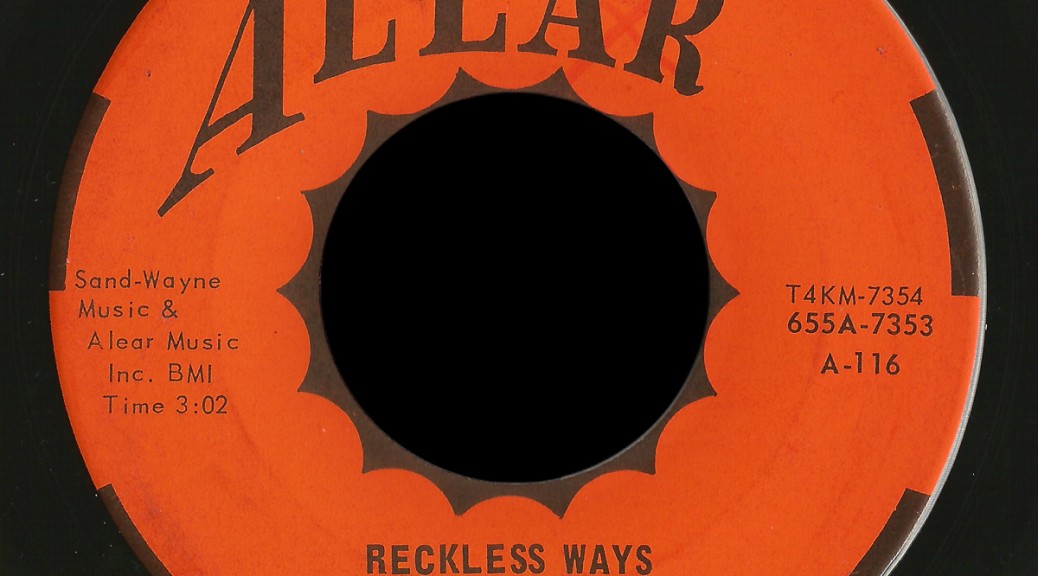
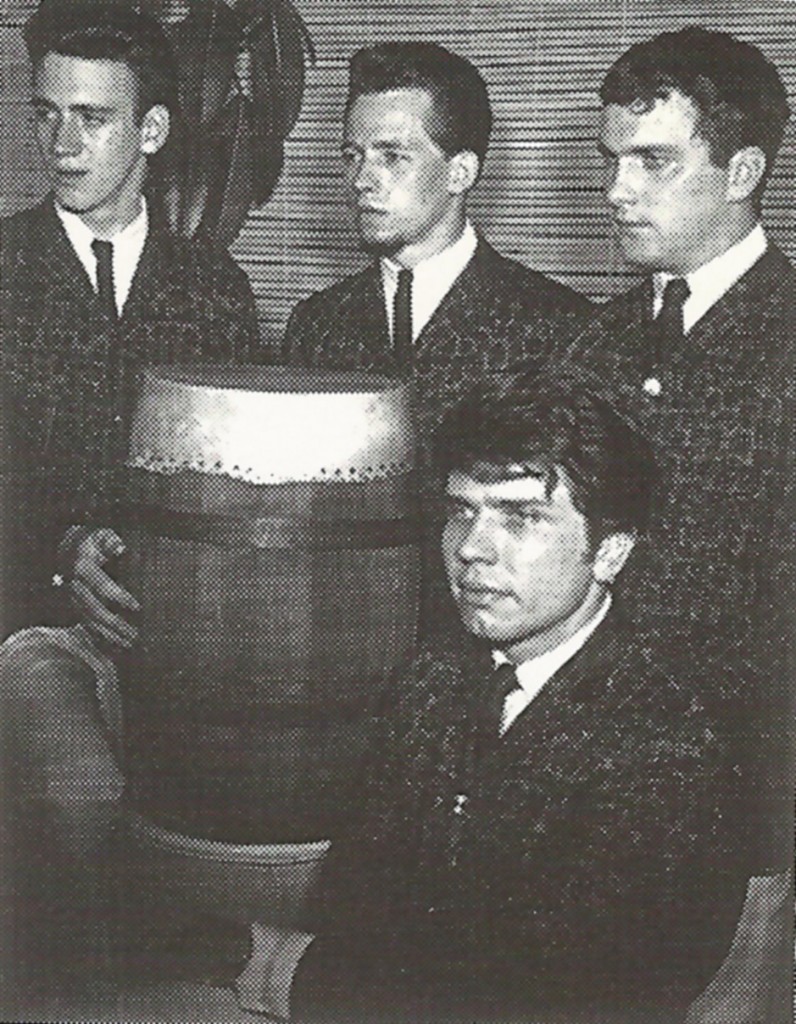 The Smacks h
The Smacks h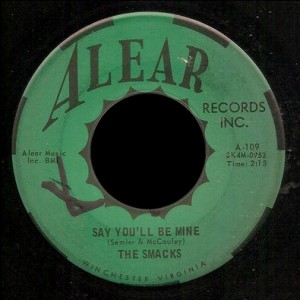 ad two primary members, Lloyd Semler from Hagerstown, Maryland, and Bill McCauley from Winchester, Virginia. Both towns are along the I-81 corridor, about 45 minutes drive apart. Other members include John Glosser on bass and David Hall on drums.
ad two primary members, Lloyd Semler from Hagerstown, Maryland, and Bill McCauley from Winchester, Virginia. Both towns are along the I-81 corridor, about 45 minutes drive apart. Other members include John Glosser on bass and David Hall on drums.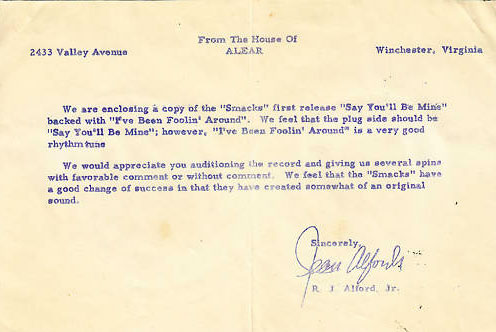
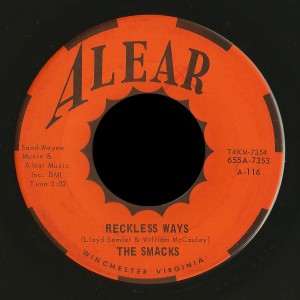 e liner notes to the excellent CD Aliens, Psychos & Wild Things, vol. 2, “Their first 45 was recorded at Accent Sound in Baltimore. The second was done in Harrisonburg at Weaver Sound in Spring ’66. The organist on ‘Nobody Else Is Gonna Do’ may be Front Royal’s soon-to-be-semi-famous, Roger Powell. The unreleased ‘There’ll Come a Day’ is the Smacks backing up two sisters from Winchester whose names are not recalled. Both Smacks discs came out on Alear, a Winchester label run by Jean Alford.” Front Royal is just south of Winchester.
e liner notes to the excellent CD Aliens, Psychos & Wild Things, vol. 2, “Their first 45 was recorded at Accent Sound in Baltimore. The second was done in Harrisonburg at Weaver Sound in Spring ’66. The organist on ‘Nobody Else Is Gonna Do’ may be Front Royal’s soon-to-be-semi-famous, Roger Powell. The unreleased ‘There’ll Come a Day’ is the Smacks backing up two sisters from Winchester whose names are not recalled. Both Smacks discs came out on Alear, a Winchester label run by Jean Alford.” Front Royal is just south of Winchester.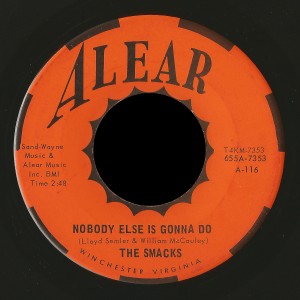
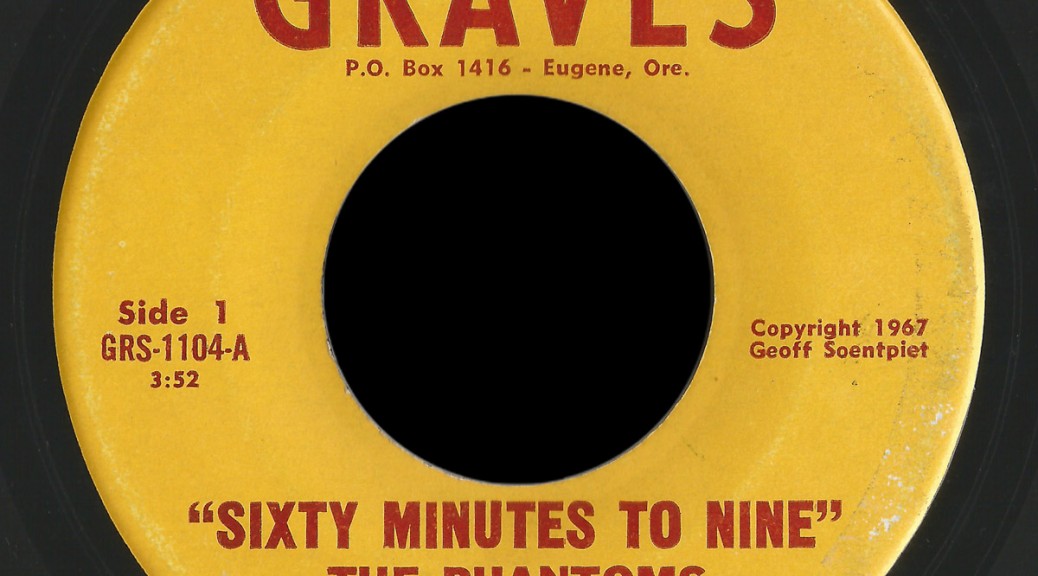
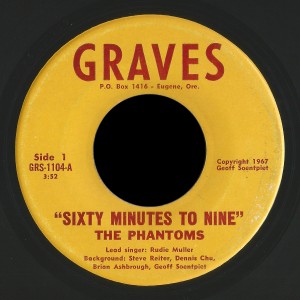
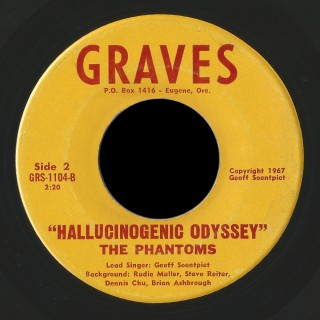
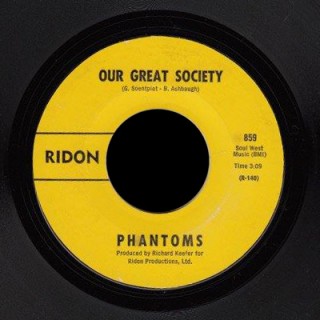
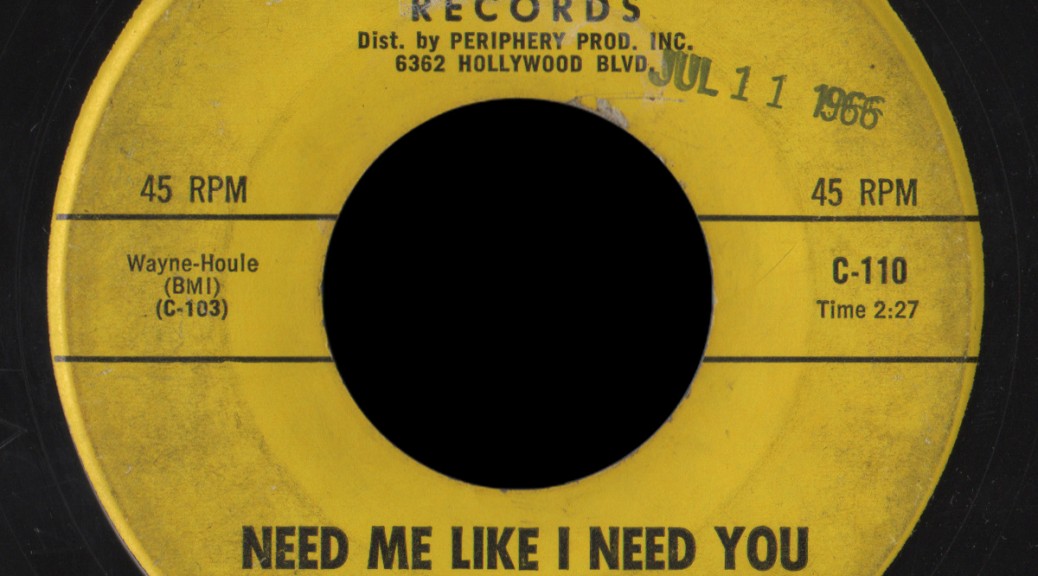


 In 1964, John Fisher was president of Crusader Records, where he produced a sizeable hit, Terry Stafford’s “Suspicion”, the second release on the label, as well as a 45 by Johnny Fortune. A notice in Billboard on August 15, 1964 announced that Fisher departed Crusader suddenly, to be replaced by Harry Maselow.
In 1964, John Fisher was president of Crusader Records, where he produced a sizeable hit, Terry Stafford’s “Suspicion”, the second release on the label, as well as a 45 by Johnny Fortune. A notice in Billboard on August 15, 1964 announced that Fisher departed Crusader suddenly, to be replaced by Harry Maselow.



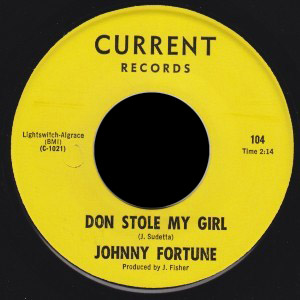
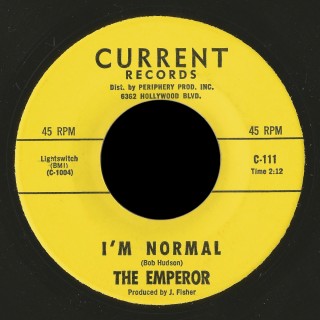
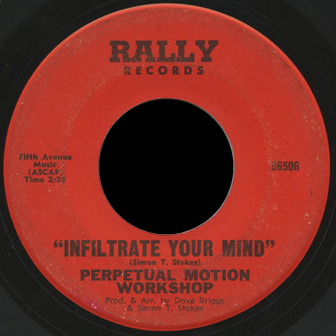



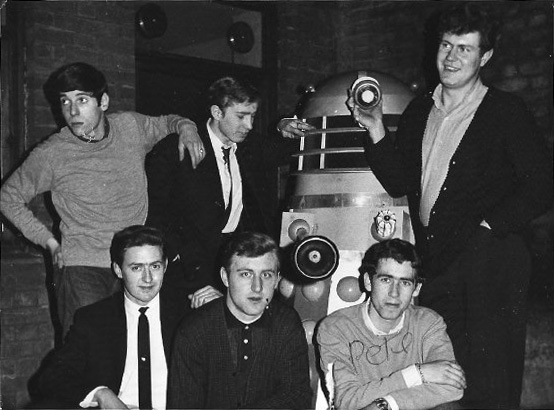

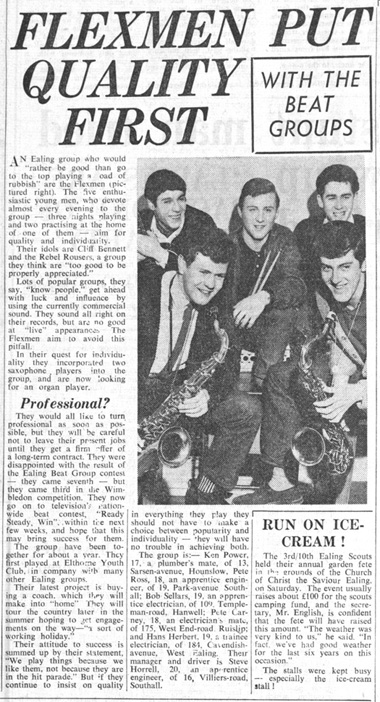
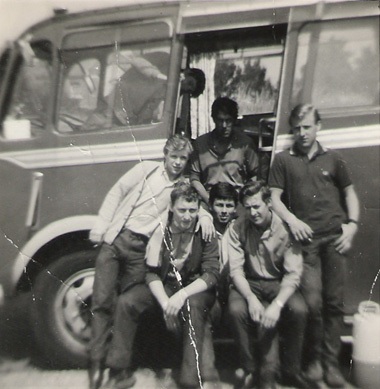
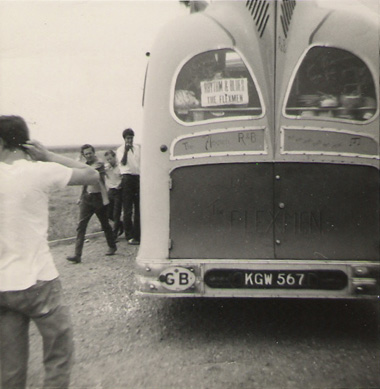
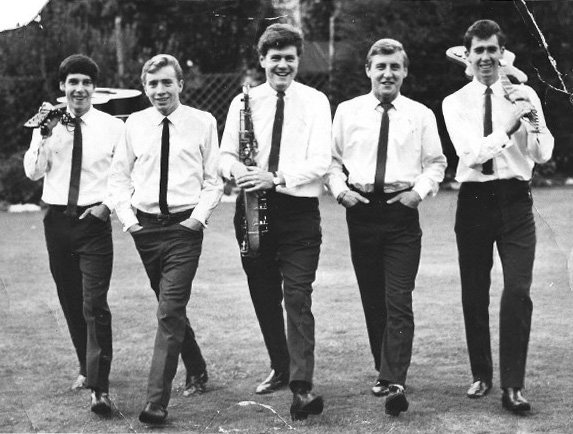
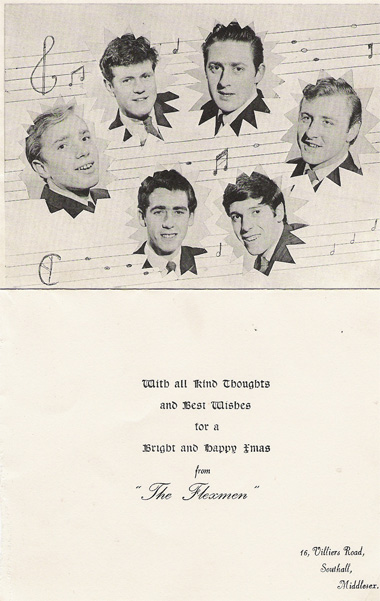
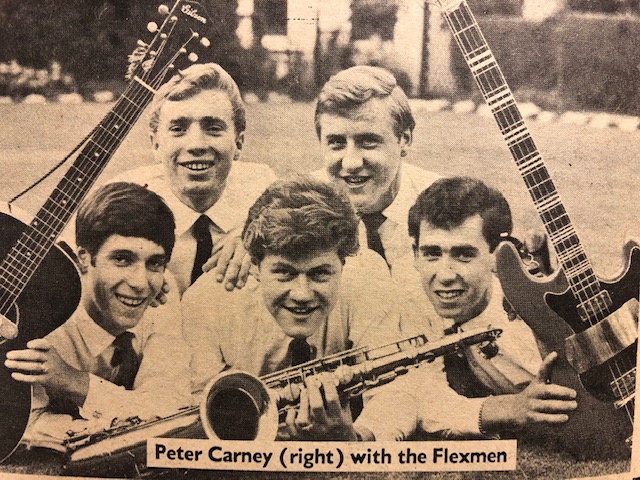
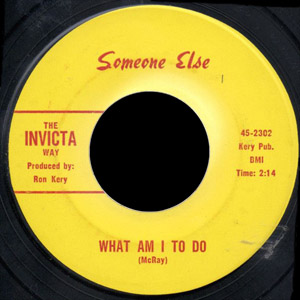

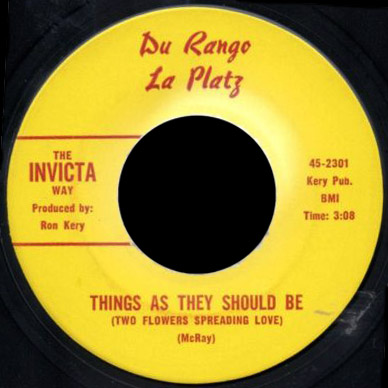




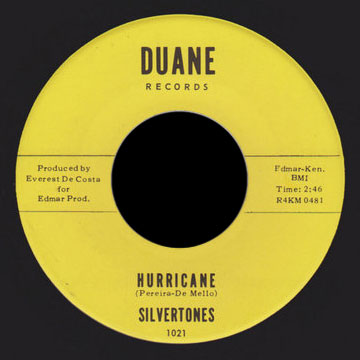
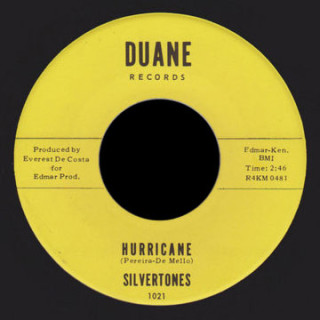
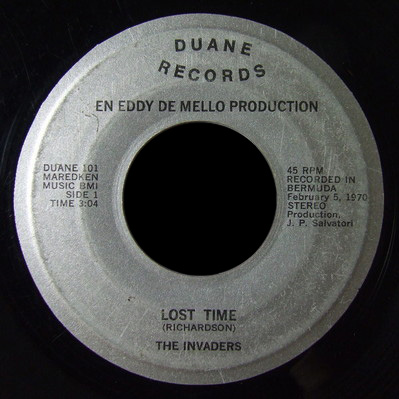 The Weads, the Savages and the Gents are all the great garage records. See my pages
The Weads, the Savages and the Gents are all the great garage records. See my pages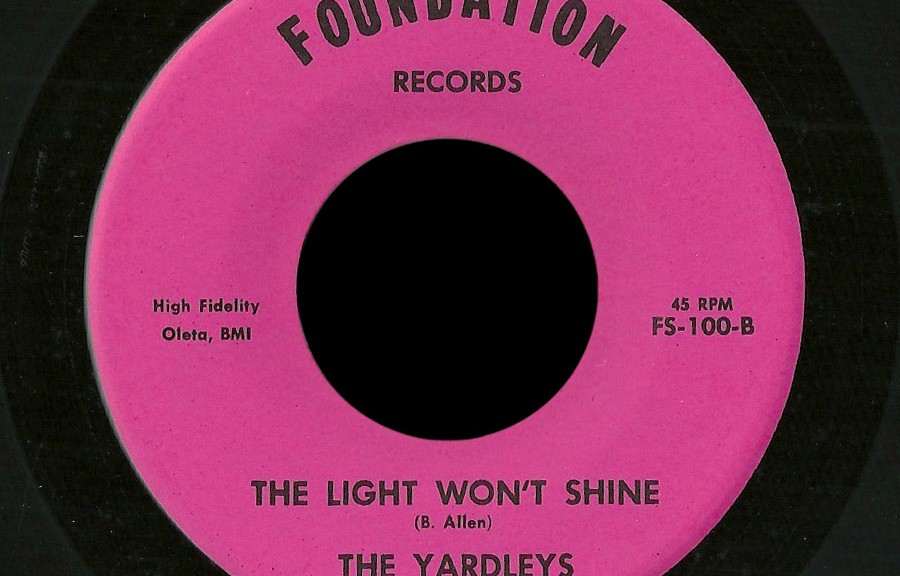
 from Pine Bluff in Teen Beat Mayhem, and from Alabama in Gear Fab’s Psychedelic States CD series!
from Pine Bluff in Teen Beat Mayhem, and from Alabama in Gear Fab’s Psychedelic States CD series!
